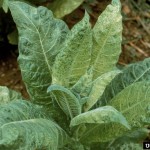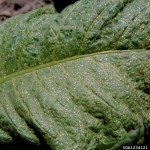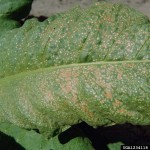Etch (Tobacco Etch Virus [TEV] )
Recommended resistant varieties: NC 291
Pictures provided by R.J. Reynolds Tobacco Company Slide Set, R.J. Reynolds Tobacco Company, Bugwood.org and Clemson University – USDA Cooperative Extension Slide Series, Bugwood.org
Tobacco etch virus (TEV) infects tomatoes and peppers along with other plants in the Solanaceae family.
Leaves of TEV infected plants are severely mottled, puckered, and wrinkled, and plants infected at an early age are severely stunted. The younger plants are at time of infection, the greater the reduction in yield.
The occurrence of TEV in tomato fields is closely associated with other infected solanaceous crops, especially pepper, and natural weed hosts, which serve as virus reservoirs. Thistle, lamb’s quarter, sickle pod, jimsonweed, and black nightshade, among others, can act as alternate hosts for TEV. The virus can be transmitted by at least 10 species of aphid in the non-persistent manner, meaning the aphids need to feed on a TEV-infected plant for only a few seconds to pick up the virus. There are no reports of seed transmission in any host plant.
TEV can be controlled by the following strategies. Eradicate all biennial and perennial weeds and wild reservoir hosts in and around fields. Maintain a distance of at least 30 yards between susceptible crops and weeds or other susceptible plants, including those in ditch banks, hedge or fence rows, and other locations. Plant late settings as far as possible from fields used to produce early tomatoes and peppers. These areas can act as sources of viruses and aphids for subsequent crops. Scout fields for the first occurrence of virus disease. Where feasible, pull up and destroy infected plants but only after spraying them thoroughly with an insecticide to kill any insects they may be harboring. Lastly, monitor aphid populations early in the season and apply insecticide treatments when needed.


